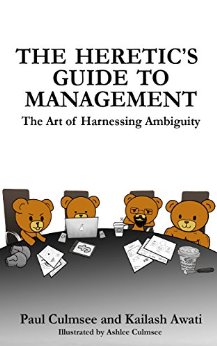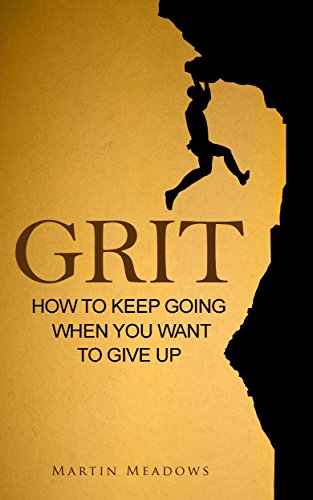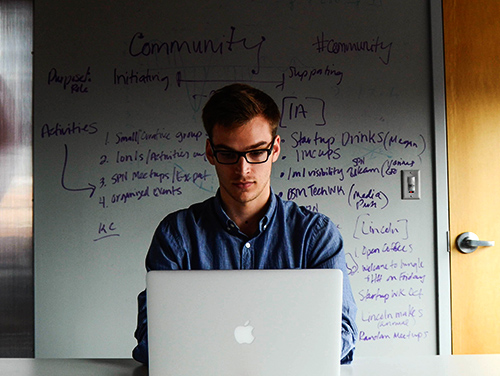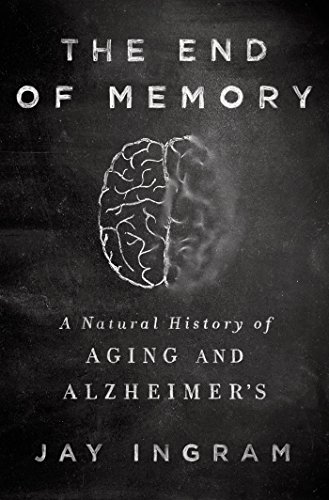Robert Bogue
November 2, 2016
No Comments
I’ve read more than a few marketing books. The list with book reviews of marketing books include Brand, Demand, Fascinate, Guerilla Marketing, and The New Rules of Marketing and PR. I’ve also spent a lot of time working through neurology and psychology, which has led to perspectives on how people make decisions and how, though we like to believe we’re rational creatures, we’re really anything but.
While writing up my book review for Incognito, I realized that none of the books that I’ve read really discussed in any detail how people behave when they feel like they’re in a group together. There have been discussions of what happens when people are separated in the “us and them” groups. (Such as the Nazi concentration camps, which was the subject of Man’s Search for Meaning.) However, understanding how to create and leverage affinity groups hasn’t been a topic of deep study. I subsequently read Influencer, and again I was surprised at how little there was about how identifying with a group is an important social pressure. There’s the comment or two about how innovators can work against you, because they’re not perceived as being in the group with the rest of the population, but still very little on how one identifies with a group and how powerful that can be. (By the way, the idea that early adopters can hurt you runs slightly contrary to the thoughts in Diffusion of Innovations.)
Rational Decisions
Before we can dip our toes into the murky water of how we make decisions, we have to dispense with the delusion that we make decisions rationally. Thinking: Fast and Slow showed us that our automatic system (System 1) can lie to our rational system (System 2), and we won’t know the lie happened. Incognito spoke extensively about how we rationalize what we’ve already decided subconsciously. The Happiness Hypothesis and Switch spoke of the Elephant-Rider-Path model that says that our rationality is a tiny rider sitting atop of a massive elephant of emotion that drives us. Sources of Power spoke of Recognition-Primed Decisions (RPD) and how hard it was to get experienced fire captains to acknowledge that they had built a mental model based on their experience and had used that – without being cognitively aware of it. Over and over again, there is evidence that we don’t make rational decisions – we rationalize the decisions that we’ve already made emotionally or unconsciously.
Giving up the fiction of rational decisions opens us up to the question about how we are influenced to make decisions. We can start to look at the hidden messages that we attach to our behaviors and investigate the small forces that act on us when we’re making decisions, such that even a small nudge in one direction or another can send us down a radically different path. (See the Butterfly Effect for more on small changes and large outcomes.)
Connecting with Others
We are, at our core, social beings. We’re designed to be connected to one another. I described in detail how experts, including Robin Dunbar, think about the groups of people that we have stable social relationships with in my post, High Orbit – Respecting Grieving. We’re connected to others and we deeply desire to remain connected to others. This is so true, that even when we’re asked to raise problems when we discover them, if the culture isn’t open we’ll often hold back on important information because it’s negative. We don’t want someone to not like us just because we made a mistake.
It’s like we’re constantly stuck on the elementary school yard vying for the attention of the “cool kids” or the “cute guy/girl”. Somehow our brains never get past the first feeling of rejection, and continue to play out a drama of trying to be accepted over and over again. We yearn to be connected because our evolutionary biology drives us to be so. (See Spiritual Evolution for more on how our evolution shaped us.)
At the heart of all of our desire for affinity groups – and the reason that we look for them everywhere we go – is this deep desire to be connected. As social creatures with the longest child-rearing times, we simply need to be in a community – any community – to ensure our survival as a species. Being connected to social groups increases our probably of survival and therefore reproduction – and create the cycle over again. Our evolution drove us towards a natural awareness of the importance of groups.
Brand Marketing
Often people see brand marketing and believe it has to do with fonts, colors, and logos. However, nothing could be further from the truth. The truth is that brand marketing is about selling someone an experience that they can’t get on their own. The brand sells the allure of being a jet pilot or race car driver (Tag Heuer). The brand sells exclusivity (Rolex). The brand sells simplicity and uniqueness (Apple). Brands are all about the feeling that the user gets when they buy your product. Sure, Starbucks makes a great coffee, but have you ever been just to say that you went?
The fonts, colors, and logos are just designed to signal to the consumer that they’re in the brand promise. That needs to be as clear as possible to prevent the erosion of the brand. The brand itself isn’t these technical details. Again, the brand is the feeling that it evokes inside of you. The stronger the brand, the clearer the brand promise and message are.
Brand promises are difficult to get right, because you never know what will resonate with your audience. A small motorcycle manufacturer with a lousy quality record was able to capture a substantial portion of the market with an outlaw image. Harley Davidson found that their market wanted the “bad boy” image more than any of the other images of efficiency, reliability, or value. The consumers wanted to express their rebel side, and Harley Davidson gave them that.
In the fast-food category, the McDonalds brand signals low cost and high consistency. Brands like Chipotle (owned by McDonalds) has a brand promise about good, non-burger, food delivered fast. Competitors have tried other approaches. Wendy’s famous “Where’s the beef?” campaign touted their portions (or ratios). Burger King’s marketing was focused on delivering the message that you can “have it your way!”
Each brand has one—or more – brand promises that you’re trying to get in your life. If you’re looking for more meat in your food, stop at Wendy’s. If you want it your way, then Burger King may be your answer. The idea is that, by resonating better with what the real users want, you’ll get more of the market and thus have success. From the consumer side, we’re looking to identify with the brand’s promise. We want to be seen as someone who has the exclusivity of Rolex or the ruggedness of Tag Heuer.
Putting On Brands
We wear brands as a way to enhance our status. We’ll wear the Nike swoosh on our shirt. We’ll make sure that the mighty apple is on our car to signify our love of all things that Apple makes. We cloak ourselves in the brands to attach our self-image and our self-worth to the image that the brand is selling. We credential ourselves with brands all the time. By connecting to the brand we are able to allow our ego to compensate for a weakness and build ourselves up. (See Change or Die for more on our ego.)
We cloak ourselves in things that make us appear to be more than we are. Folks with a high status motivation (See Who Am I? for Reiss’ 16 motivators) have to cloak themselves in the best things. They have a high need to be perceived as above or in the elite group. They’ll drive a Land Rover and not a Jeep; or a Ferrari, not a Corvette. To those obsessed with status, they have to cloak themselves in whatever brand seems to be the best.
The word “cloak” here is used because it implies that we’re trying to hide our true selves. We don’t necessarily feel like we are the best, that we’re worthy of the best, or that we are what the brand implies – but we want to be.
Connecting Brands to Connectedness
Once we understand our need for connectedness and the fact that brands centrally make a brand promise, we can connect our need for connection and the idea of brands together. Brands are connecting us to that ideal self. That is, brands allow us to pretend to be the person we really want to be. We don’t have to actually be a better person; we can buy something and instantly become it. It seems like more and more of us are electing the easier path of buying our ego a tool to help us believe that we’re our ideal self – and that people will want to be us or be around us.
We’re not connecting as well today as we did a generation ago. Robert Putnam’s book Bowling Alone clearly shows that all of the data points to the fact that we’re losing our connectivity in social groups. We’re joining social clubs less frequently and we’re attending church less regularly. (See The Great Evangelical Recession for more on church attendance — or lack thereof.)
Brands represent the equivalent of relational candy. They provide the feeling of connectedness without an actual connection. This isn’t necessarily a bad thing: there are times when a little sweet is just what we need to feel better. However, a steady diet of candies – or brands – isn’t necessarily good for our health.
Somewhere in the middle, between brands and our need for connection, are the groups that we belong to. They don’t have the clarity of message as a strong brand but, by nature of their mission, focus, and membership, they can signal a message that makes you feel even more connected and more alive.
Creating Strong Affinity
A brand creates a very wide but very shallow influence on people. The affinity or attraction to the brand message is broad enough to impact a large number of people – but the relative impact will be weak. You won’t “take a bullet” for Tag Heuer, but you might buy a watch. Certainly in the realm of marketing, our goal is often to create a purchase transaction and so even a small brand impact is sufficient. However, the same powers that drive brands can drive stronger influences for a smaller group of people. In fact, the more exclusive the brand, the more impactful the influence can be. Ferrari may not sell a lot of cars, but people pay a lot for the cars they do sell. The fewer people who can partake of the brand, the more powerful it can be.
Most small groups, however, are not brands in the traditional sense. Instead they’re the groups that we belong to. These are where we have some level of real connectedness, not just an illusion, as well as a shared experience. If you want to create real impact in a group, the kind of impact where someone might really “take a bullet” for someone else, you need to create a small group of people with a common objective. Collaborative Intelligence touched on the dynamics of building teams when the stakes – and egos – are high. While it can be difficult to create the kind of tight bonding that makes a team work well – and allows team members to impact one another – it’s definitely possible.
Paintball
Many years ago when I was only a handful of years into the Microsoft MVP program, there was a product team member, Lawrence Liu, who really knew how to create a community. He instituted a pre-MVP Summit paint ball excursion where all of the SharePoint MVPs who had come to the event would pair off on teams and battle. At the time it seemed like a great opportunity to exact relatively harmless revenge on some of the other community members with whom I was upset. However, there were deeper forces operating. We got an opportunity to see each other differently. We got to build a shared experience that would tie us together. As a result of the struggle that we went through together, we bonded more closely than we would have been able to if we had sat in a room and talked all day. It’s through this experience that I can glimpse an understanding of how military teams become bonded for life.
The genius of the event was that it was able to create a struggle to win – which pulled the folks on the team closer together. It simultaneously built an opportunity for respect of the members of the other team who were playing well. It even gave us a respect for the folks who were willing to go above and beyond. This included the two people who brought gully suits. Of course, by the fourth time the event was run, its power to bond us had waned. By then Lawrence had moved on and we didn’t replace the event with another suitably useful event. Instead the group had grown beyond the 50 or so people we used to have and we didn’t find events that were suitably able to pull us together.
Wider Ripples
The paintball experience was just for the SharePoint MVPs. However, it was connected to the MVP Summit, a quasi-annual gathering in Redmond where we’d visit with other MVPs and the Microsoft product teams making the products that we were using. These events were often boring events punctuated by a few minutes of sparky conversations. While engineered as sessions for the product teams to share their thoughts and MVPs to provide feedback within the confines of a non-disclosure agreement (NDA), they didn’t always meet this mark. By the time the event happened, the product teams were often too far along in their processes to hear the feedback that the MVPs were providing. I vividly remember some rather direct and perhaps uncaring feedback occurring too late in process to resolve issues in a product release plan. However, in the midst of this there were interesting interactions with other MVPs with other areas of specialty.
I’ve long since learned that the best conversations that I have at a conference or event may be at the breakfast or lunch table. People are often so self-absorbed in what is going to happen that they fail to be in the moment and attend to those they are with. For me, I strike up conversations at tables and try to learn as much as I can about the people at the table and what makes them tick. As a consultant I get the opportunity to get called into a lot of different industries and organizations and I love that. Sitting down with people at a conference broadens that circle even more. Never is that more true than at the MVP Summits.
MVPs represent one of the most diverse groups I’ve ever met. You can have someone who is recognized as a community champion for Xbox sitting next to a SQL Server DBA who responds to thorny issues in the forums. On the whole, the folks at an MVP Summit are more technical and less relational but not exclusively so. This is a particularly energizing time because the MVPs know that they’re “with their own”; that is, people who share a passion for sharing what they know with others – even if the technology isn’t the same.
I’ve built a respect for all MVPs, and not just the SharePoint MVPs that I played paintball with, because of these conversations – and honestly because the impacts of the paintball connectivity were diffused through the entire MVP group. The proximity of location and time allowed me to automatically transfer some of the affinity to the SharePoint MVPs to the larger group. The SharePoint MVPs were some – but not all of the people sitting at the tables.
Shared History
Paintball represents a part of the shared history of the group. Any of the guys who were there can take me back at any time by talking about the day. In doing so, they rekindle the spirit of teamwork, cooperation, and interdependency that existed that day. Even less impactful events have power over us today. Consider bumping into someone from elementary school – even someone whom you would have considered a rival back then. For most people, this reconnection will be a positive one. Even if it’s a fleeting moment and you don’t stay in touch, most people experience this as an intensely positive experience, because of the connection to the history that we all feel as if we’ve lost. Thinking, Fast and Slow illuminates the sunk-cost fallacy, where we overvalue investments we’ve already made. We tend to value the things that we’ve spent. Similarly, we tend to value our history greatly
Rarely is it that I meet someone from my past when it’s a negative experience. Most often the power of shared history and the desire to recapture it outweighs any negative memories I have of the person themselves. We like to think of our memories as immutable, that they can’t be changed. However, Redirect invested a great deal of time in explaining the process of story editing – that is, changing our beliefs about our memories. While this is an active process, there’s a passive process that happens where we redefine the conflicts that we had with someone and see it with the perspective of time. (Science and Pseudoscience in Clinical Psychology describes the malleability of memory more clinically.)
When you’re locked in a battle for the “right” way forward, your perspective and the urgency of doing the right thing, whatever the issue is, will seem to be the largest thing. However, the passage of time has a tendency to refocus us on relationships and people and reduce our focus on being right or on things. Bowling Alone‘s focus on generational differences exposed that we’re more active in community, groups, and philanthropy during our later years than we are early on in our twenties. As a result, for the most part, you’d rather have a conversation about old times with someone who was your rival than you would look the other way as they come down the street.
Pay It Forward
The idea of reciprocity is woven deep into our makeup. It shows up on the negative side as vengeance. (See Who Am I? for more on vengeance as a value.) On the positive side, we see reciprocity show up in marketing and sales – if we give the customer something, they’ll want to give us something back. The groups that we become a part of give us something that we all need – that is, belonging. Reciprocity works its way in and we naturally want to give back to the group – which we do by giving to the members.
In a sense, groups take our natural tendency to reciprocate and allow us to accomplish it through the group as “pay it forward.” That is, we get some value from the group through membership – or perhaps through someone specifically helping us – and in turn we help someone in the group. This creates a virtuous cycle or a positive reinforcing loop. (See The Fifth Discipline and Thinking in Systems for reinforcing loops.)
Us and Them
At our core, we’re all trying to define the groups that we belong in. We have an affinity with in-group words. (See Mistakes Were Made (But Not by Me) for more about research on affinity of in-group words.) It’s woven deep into our collective consciousness. To be exiled – to be excluded from the community group – used to be a death sentence. When we more obviously needed communities than we need them today, if you were on the outside, you were outside the protection from the community, and your chances of death were much higher.
In the 80s there was a popular brand of clothing called Members Only. Because it was an 80s fad, it’s become the butt of jokes in Seinfeld
and Shallow Hal about people being “the last member”. However, the brand’s core message – that you can be a part of a members-only group – has inherent appeal to us as humans. Warehouse clubs like Sam’s Club and Costco describe their customers as members because of the membership fee that’s charged, which proves that we’ll pay money to be a part of a store that we can spend our money on.
Groups of Power
It was a disturbing trend. Larger store chains were starting to force independent grocers out of the business as early as the late 1920s and 1930s – though the real pressure would come much later. Market capitalism was allowing some more powerful grocery chains to expand and to choke independent grocers out of the business through their economies of scale. They could buy food cheaper and therefore sell it cheaper. In an industry that works with very thin margins, even a few percentage points of price reduction can be the difference between survival – and lack of survival. So what’s the small grocer to do? The answer is to form your own group, as happened in 1926, when 100 independent retailers came together to form the Independent Grocers Alliance, which most people from small towns simply know as their hometown IGA.
I can remember the IGA grocers in the small towns and communities that I visited throughout Indiana and on vacations out of the state. While the larger cities’ grocery markets were dominated by larger chains, IGA seemed to be woven into the fabric of the small communities. While there are still IGA stores in some of the small towns that I visit, they are fewer and fewer each year. Despite their seemingly losing battle, the concept of gathering together a large group of independent businesses to harness greater buying power and to gain some of the economies of scale that their competitors were enjoying was genius.
They aggregated the power of many independent entities in the service of the greater good. This isn’t unlike how communities were started, wagon trains were gathered, or any of the other ways that we’ve banded together as a society and it represents an awareness of our interconnectedness and our need for other people to survive – and thrive.
Family
Perhaps the most powerful affinity group for most of us is our family. Our nuclear family is obviously the people that we spend the most time with and with whom we have the most shared experiences; but more broadly, family is a big deal.
For some, blood lines are critical. Whether you’re a monarch of a country in Europe or simply a proud family from Kentucky, who marries whom and the legacy of your family name has a big impact. Family is – because of blood – something treated special.
In truth, if you got a call from a cousin you barely remember asking for a place to stay or a bit of small financial help, you’d likely help out without much of a second thought. You would turn to your spouse and utter only, “they’re family.” And, in all but extreme circumstances, that may be all that needs to be said. Family has an inherent affinity to it.
In the context of building affinity groups, I’m not suggesting that you marry into a family to become one of them; but rather I’m suggesting that there is an affinity to family that is strong, and therefore if you are looking for help, family may be a good place to go.
The Impact of Affinity
I started with the idea that affinity groups allow you to exercise influence over others. Certainly the psychological forces that are working are strong enough to influence others. However, before considering how to influence others, it’s important to reflect on how affinity causes us to behave differently. You can measure your affinity for others by measuring what you’ll do.
Doing for Others – That Which You Wouldn’t Do For Yourself
An interesting demonstration of commitment to another for me is the observation that you’ll do something for them that you won’t do for yourself. For instance, if you would hire out having someone remove wallpaper for you – but you are willing to go and remove wallpaper for a family member – that represents a very strong statement to me. It’s one of the ways that I measure how important other folks are to me. One might wonder why I wouldn’t hire it out for them. Besides the rather obvious reason that it’s less socially acceptable, there’s also the reason that the fact that I’m doing it myself conveys more meaning and importance.
While this is a high bar for what you would do for others, and it’s probably something reserved for very few people, it is a crystalline way of demonstrating how much influence someone has on another person.
Doing for Others – That Which You Wouldn’t Do For Money
A second level of commitment is when you’ll do something for someone else who won’t do it for money. I’ve spoken about my video studio in the past. While we’re considering allowing folks to rent the space, it won’t be me doing the video work in the studio. However, from time to time, folks come by who need a “head shot” for a web site or a business card. I’ll sometimes do these photos as a favor for folks when I wouldn’t do them for a fee. Why wouldn’t I do them for a fee? Well it isn’t a business I want to start. It’s not that I can’t do a good job or that I don’t enjoy it. It’s that I don’t want to do it all day, every day. The bar for reaching this level is much lower than the bar for doing things that I wouldn’t do for myself, but there’s a certain level of affinity that I have to have to be willing to extend myself.
Doing for Others – That Which You’ll Do for Money
Still a lower level of affinity is one where you’ll overextend yourself with work to do something. If you’re a consultant, this means going over your typical commitment. If you’re an employee it means doing a job on the side. You’re still expecting to be paid. However, you don’t have time really – -you’re giving up something important to you. Whether that’s resting at home, time with the family, or time at a club, you’re making some sort of a sacrifice.
Going Deep
For me, the concept of affinity groups is about how we’re connected to one another. It’s about how we make our decisions and how we fulfil our inherent need to be connected. Affinity groups allow us to recognize that we’re all part of the same human race, that we’re a part of an elite group of the human race, and we can recognize that we’re all unique and different – all at the same time. The next time you make a decision, maybe consider how affinity groups played a part in that decision.










